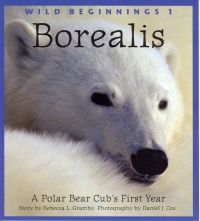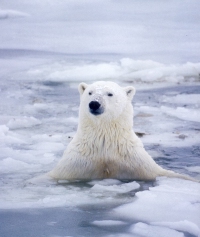| ________________
CM . . .
. Volume X Number 12. . . . February 13, 2004

 |
Borealis: A Polar Bear Cub's First Year. (Wild Beginnings, #1).
Rebecca L. Grambo. Photographs by Daniel J. Cox.
North Vancouver, BC: Walrus Books/Whitecap Books, 2003.
48 pp., pbk., $14.94.
ISBN 1-55285-465-5.
Subject Heading:
Polar bear-Juvenile literature.
Grades 2-4 / Ages 7-9.
Review by Gillian Richardson.
*** /4 |

excerpt:
"There is too much sunshine," a hot, grumpy Borealis complained. He had noticed the sun staying in the sky a little longer each day since they had left the den. "Pretty soon it will be light all the time and I'll melt."
"Don't worry," Mama said. "The longest day of the year is just a few days away. After that, every night lasts a little longer until the middle of winter. Then night starts to shrink and the days grow longer again."
"Why do the days change like that?" asked Borealis.
"I don't know. A bear I knew once heard some people talk about Earth being tilted, with the top tipped toward the sun for half the year and away for the other half. Maybe light and dark agreed long ago to share the seasons this way. It has been the same for as long as bears remember."
Borealis, the first title in a new series called "Wild Beginnings," presents a tour of seasons in the Northern tundra as it relates to the life of the polar bear. The story unfolds through the viewpoint of a new cub, Borealis, and his mama from the time they emerge from the den near Churchill, Manitoba, in March. As they wander in search of food, Mama answers the young cub's questions about their habitat and the habits of polar bears and the other wildlife with whom they share territory on land and sea. The book is promoted as a creative approach to nonfiction as it relies on fictional dialogue between the bears to introduce the factual content. The author's passion for nature study is obvious by her eye for detail. The text is nicely integrated with excellent, color close-up photos of the animals in their environment. Cool blues and greens used for most of the text pages wrap the reader in the aura of the Arctic. Two pages of additional facts and a limited index follow the story.
 The fact/fiction hybrid and the readability level make this book awkward to categorize as far as intended audience. It is classified as nonfiction, although the invented dialogue puts it equally into the realm of fiction. Youngsters strictly in search of facts may be put off by the story style. It may be best described as a story picture book, although there isn't a classic plot. The cub mimics a preschooler with his constant questions, possibly placing the fictional component below the interest level of an independent reader. There are a number of full pages of text and some longish sentences. Once past the slow introduction with its stylized map and rather wordy setting description, this book could be an effective read aloud. Beginning with the action surrounding the cub's birth, young listeners would likely be charmed by the innocent curiosity of Borealis and the warmth and gentle humor that characterizes the bears' relationship. The fact/fiction hybrid and the readability level make this book awkward to categorize as far as intended audience. It is classified as nonfiction, although the invented dialogue puts it equally into the realm of fiction. Youngsters strictly in search of facts may be put off by the story style. It may be best described as a story picture book, although there isn't a classic plot. The cub mimics a preschooler with his constant questions, possibly placing the fictional component below the interest level of an independent reader. There are a number of full pages of text and some longish sentences. Once past the slow introduction with its stylized map and rather wordy setting description, this book could be an effective read aloud. Beginning with the action surrounding the cub's birth, young listeners would likely be charmed by the innocent curiosity of Borealis and the warmth and gentle humor that characterizes the bears' relationship.
Recommended.
Gillian Richardson, a freelance writer and former teacher-librarian, lives in BC.

To comment
on this title or this review, send mail to cm@umanitoba.ca.
Copyright © the Manitoba Library Association. Reproduction for personal
use is permitted only if this copyright notice is maintained. Any
other reproduction is prohibited without permission.
NEXT REVIEW |TABLE OF CONTENTS FOR THIS ISSUE
- February 13, 2004.
AUTHORS
| TITLES | MEDIA REVIEWS
| PROFILES
| BACK ISSUES
| SEARCH | CMARCHIVE
| HOME |

 The fact/fiction hybrid and the readability level make this book awkward to categorize as far as intended audience. It is classified as nonfiction, although the invented dialogue puts it equally into the realm of fiction. Youngsters strictly in search of facts may be put off by the story style. It may be best described as a story picture book, although there isn't a classic plot. The cub mimics a preschooler with his constant questions, possibly placing the fictional component below the interest level of an independent reader. There are a number of full pages of text and some longish sentences. Once past the slow introduction with its stylized map and rather wordy setting description, this book could be an effective read aloud. Beginning with the action surrounding the cub's birth, young listeners would likely be charmed by the innocent curiosity of Borealis and the warmth and gentle humor that characterizes the bears' relationship.
The fact/fiction hybrid and the readability level make this book awkward to categorize as far as intended audience. It is classified as nonfiction, although the invented dialogue puts it equally into the realm of fiction. Youngsters strictly in search of facts may be put off by the story style. It may be best described as a story picture book, although there isn't a classic plot. The cub mimics a preschooler with his constant questions, possibly placing the fictional component below the interest level of an independent reader. There are a number of full pages of text and some longish sentences. Once past the slow introduction with its stylized map and rather wordy setting description, this book could be an effective read aloud. Beginning with the action surrounding the cub's birth, young listeners would likely be charmed by the innocent curiosity of Borealis and the warmth and gentle humor that characterizes the bears' relationship.